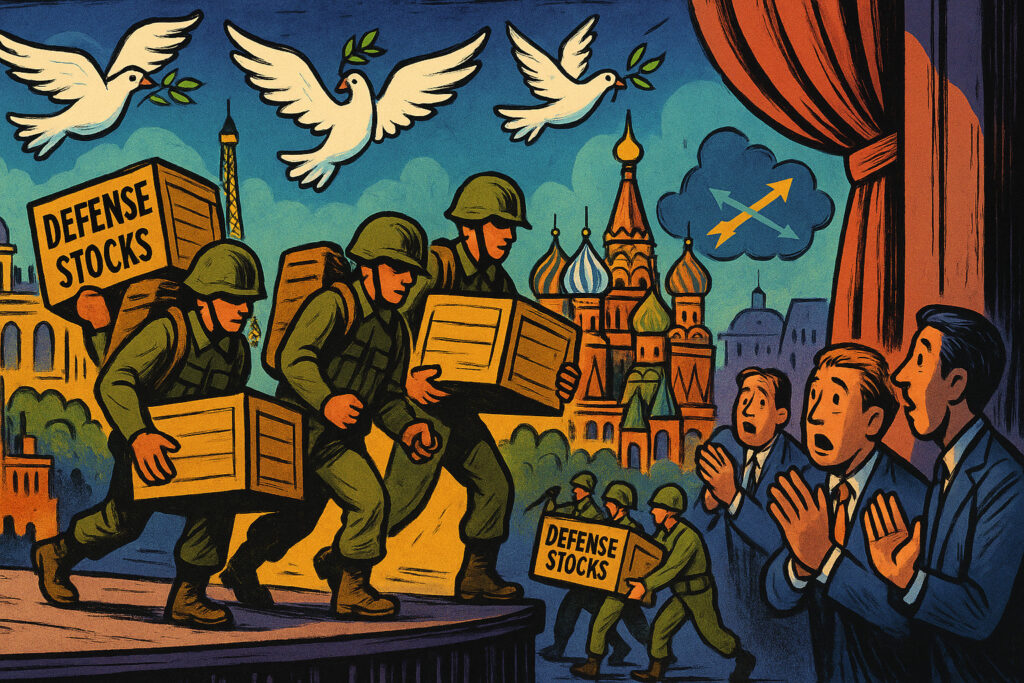Introduction
On 19 August 2025, global markets showcased a clear divergence: European equity markets gained ground buoyed by rising hopes for a peace settlement in Ukraine, while U.S. markets treaded cautiously amid concerns over tech and Fed signals. Investors in Europe rallied behind optimistic diplomatic developments, while Wall Street’s momentum faltered amid structural risks and geopolitical uncertainty. The day revealed a bifurcated market narrative—a wave of optimism on one side and measured caution on the other.
This session is significant because it marks a shifting sentiment in Europe, where recent defense sector exuberance gave way to profit-taking as peace talks advanced. Meanwhile, in the United States, markets had to balance strong retail earnings against volatile tech sectors and ambiguous central bank direction. The complexity of these cross‑currents reflects a market in transition—caught between geopolitical relief and macroeconomic unease.
European Equities Rally on Ukraine Peace Prospects
In Europe, equity markets saw a notable uplift. The FTSE 100 in the UK reached a new closing high at 9,189.22, driven by strength in retail and broad investor optimism. Other bourses followed suit: Paris’s CAC 40 rose over 1%, Frankfurt’s DAX added roughly 0.5%, and benchmark STOXX indices all posted gains. Regional markets surged on fresh hope of peace in Ukraine, as signals from diplomatic channels and headlines reassured investors.
Defence Stocks Plummet Amid Peace Optimism
Contrasting the broader rally, European defence shares faced sharp declines as hopes for a peaceful resolution dampened demand expectations. Key players like Leonardo, Hensoldt, and Rheinmetall saw their stocks fall between 5% and 10%. Even with their stellar year-to-date rallies, markets reassessed valuations, prompting funds to trim positions amid fading tailwinds. The rotation signaled a recalibration: markets were siding less with conflict-driven demand and more with diplomatic resolution.
Wall Street Pauses Ahead of Federal Reserve Clarity
Meanwhile, across the Atlantic, the tone was more subdued. Wall Street trading was cautious; benchmark indices moved little as markets digested signals from tech sectors and awaited clarity ahead of the Federal Reserve’s upcoming Jackson Hole symposium. Investors remain wary of the Fed’s stance, particularly in light of ongoing geopolitical noise and mixed earnings results.
Indian Markets Buoyed by Tax Reform Hope and Global Momentum
In Asia, India’s markets extended gains amid buoyant sentiment. The Sensex rose in the vicinity of 150 to 370 points, bringing the Nifty near the 25,000 level. Reliance Industries and Bharti Airtel led the rally, supported by investor expectations for GST reform and spill‑over optimism from global markets.
Oil and Commodity Markets Consolidate
Commodities reflected a nuanced tone. Oil prices held in a narrow range—Brent crude weakened modestly, though global benchmarks stayed elevated in anticipation of shifting geopolitics and supply fundamentals. Industrial metals showed stability, while gold maintained its safe-haven role even amid reduced risk‑aversion from peace hopes.
Fixed Income and Currency Markets Stay Balanced
Bond markets remained calm, with U.S. Treasury yields largely unchanged as geopolitical optimism was counterbalanced by lingering uncertainties. The yield curve maintained its inversion, signaling underlying growth concerns. Currency markets echoed this trend: the dollar held steady, while eastern European currencies gained modestly on peace optimism.
Investor Sentiment: Rotation Over Rally
Overall, investor sentiment shifted from conflict hedging to selective optimism. In Europe, sentiment rallied into sectors like retail but pared back on defense. In the U.S., cautious positioning reflected concerns over tech valuations and Fed ambiguity. Liquidity remained moderate, and volatility stayed subdued—suggesting that although optimism was broadening, resilience was fragile.
Conclusion
The 19 August 2025 market snapshot reveals a transitionary phase. European markets embraced peace hopes, pushing indices higher even as defense sectors faced corrections. Indian markets rode simultaneous reforms and global optimism. In contrast, U.S. markets paused, waiting for more precise direction from central banks and macroeconomic data.
Looking forward, investors should watch closely for outcomes from the Jackson Hole symposium and any new turns in Ukraine diplomacy. The key question remains: Will peace developments steer a broader economic stabilisation, or will unresolved structural risks and market complacency mar sustainability? With sentiment now balanced between cautious hope and guarded realism, the path ahead remains delicately poised.
